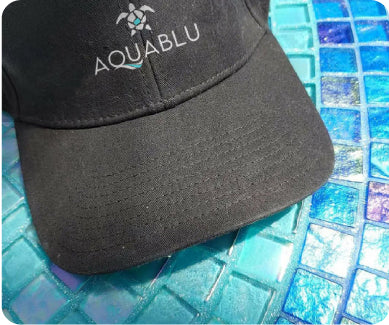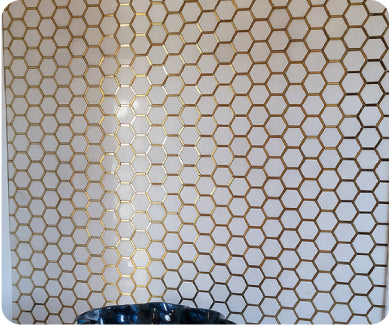How to Clean and Maintain Pool Tile

AquaBlu Mosaics features pool tiles that require amazingly little upkeep. They are impervious to liquids and vapors, and resistant to fading, staining and discoloration.
In fact, AquaBlu glass pool tiles, porcelain pool tiles and pool mosaics are guaranteed for the life of the application.
That said, all pool tiles require some maintenance from time to time. One of the most common problems:
Waterline Dirt And Grime
If you notice discoloration at your pool’s waterline, it is most likely caused by hard-water deposits. When water evaporates, calcium in the water remains and clings to the side of your pool, forming calcium deposits. These deposits appear like white or gray scum on your tile. You can prevent them by regularly scrubbing the pool walls with a pool brush and maintaining the optimum chemical levels in the pool.
Keep It Clean
Keeping your pool water clean goes a long way in minimizing pool tile maintenance issues. A good place to start is by skimming leaves off the water surface as soon as you notice them. Debris that sinks to the bottom of the pool should be vacuumed up, either manually or with an automatic vacuum. This is also where a solar cover can pay extra dividends by keeping debris out as well as maintaining water temperature.
Algae is also an enemy of pool tile. Algae forms when the chemical levels in the pool are too low. Check your chemical levels regularly and make the necessary adjustments. In the event of an algae buildup, use an algaecide first. Dead algae settles to the bottom. Five hours after using the algaecide, thoroughly vacuum the pool.
How To Deal With Stubborn Calcium Deposits
If the deposits or staining is minimal, try scrubbing the area with a toothbrush. Baking soda, vinegar and even toothpaste can also help. But if the deposits are more substantial, another approach will be needed. Here are three methods we recommend for getting rid of difficult pool tile calcium deposits. Remember, there are also cleaning pool services that will do this:
- Pumice Stone (a miracle worker) – Pumice stones can be purchased from local pool maintenance stores. They are safe to use on hard surfaces such as concrete and some tiles. However, try using a nylon bristle brush if your pool tiles are glass pool tiles, ceramic or porcelain tiles. Do not use pumice stones on vinyl or fiberglass pools. Releasers, such as the Ocean Care Calcium Releaser, will soften the calcium for removal.
Scrub the tiles in a circular motion until deposits, mildew and buildup are gone. If using a pumice stone, make sure both the tile and the stone are wet at all times while cleaning to prevent scratching.
- Pressure Washing Pool Tiles – These can be rented at hardware stores if you really want to do it yourself. You will have better results by choosing a steam pressure washer with a PSI of 2000 to 2600 that can reach a temperature of at least 300 degrees Fahrenheit.
Stand at least 3 feet away and spray the area for 30 seconds as a test. If you don’t experience problems then do a larger section. Make sure to wear protective clothing such as close-toed shoes and safety goggles.
- Acid Bath – This procedure is definitely better left to the pros. First you need to drain your pool, then, wearing protective clothing, add 1 gallon of muriatic acid to 1 gallon of water in a bucket. Apply the solution to the pool tile with an acid brush starting at the deep end of the pool, working small sections at a time using an acid-resistant scrub brush.
Once the calcium silicate scaling is removed, rinse the tile with water using a hose. After cleaning all the pool tiles, add 2 pounds of soda ash for every gallon of acid. Pump the neutralized acid out of the pool using a water pump.
Cleaning Backsplash, Wall and Floor Tiles
For non-pool tile that is glazed (such as glass tile and porcelain tile), use a sponge and dampen it with a non-oil-based household cleaner. Vacuum glazed floor tiles regularly to remove dirt and other gritty particles, then damp mop or sponge with an all-purpose, non-oil-based cleaner. If you are using soft water, use a non-oil-based, all-purpose cleaner. Let stand for five minutes then lightly scrub with a sponge and rinse thoroughly.
For unglazed wall and floor tiles, use a damp sponge or cloth with a solution of water and a brand of soap without detergent. Do not use an all-purpose cleaner. And do not use ammonia, which will discolor cement-based grout.
A Word (Or Two) About Pool Tile Grout
Our new epoxy-based pool tile grout requires little upkeep. It’s also water repellent and resistant to stains, chemicals and UV. However, the older style cement-based pool tile grout is another story. Cracking and staining are an inevitable part of its lifecycle. With cement-based grout, joints should be treated with a silicone sealer. It is recommended that you apply a sealer at least once every six months for maximum stain protection.
If you have questions, talk to one of our experts. You can call us at (800) 971-1442 or fill out our contact form. You can visit our website at https://www.aquablumosaics.com/.


































































































